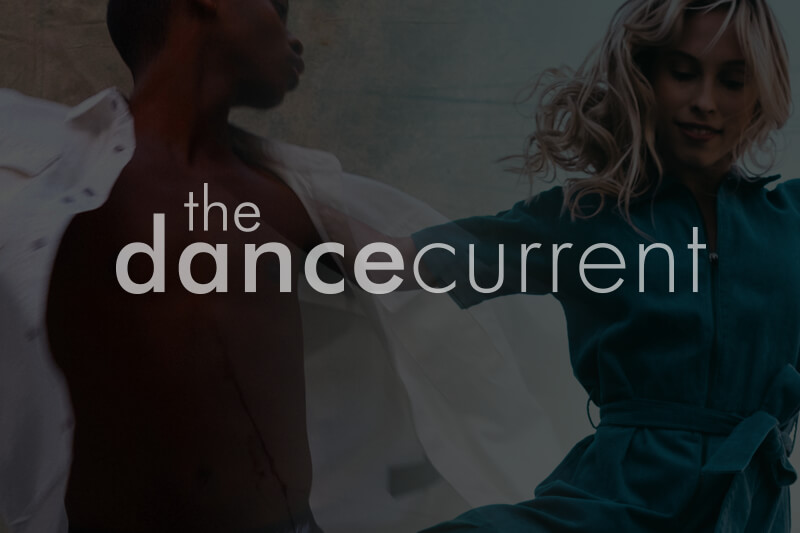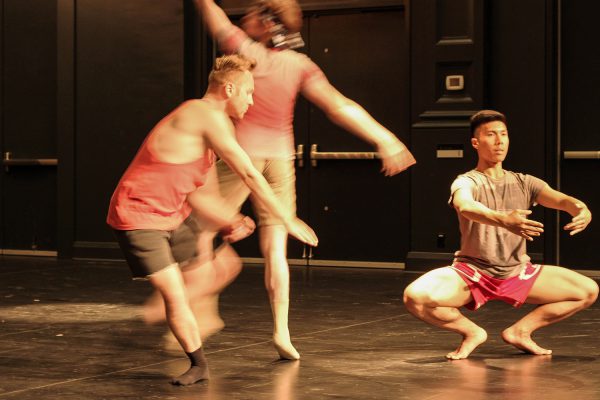Malcolm is back! For those unfamiliar with the dancer’s so far short but distinguished career, Malcolm made his stage debut at Toronto’s Harbourfront Centre in a November 2009 Coleman Lemieux & Compagnie program called “Living Dances”. There, in company with Bill Coleman and countertenor/Theatre of Early Music director Daniel Taylor, Malcolm created a role in a short work by James Kudelka called “Beautiful Movie”, somewhat incongruously set to the “Erbarme dich, mein Gott” aria from Bach’s “St. Matthew Passion”. Kudelka was inspired enough by Malcolm’s performance to choreograph yet another role for Malcolm in February, to music by an even earlier composer, Heinrich Ignaz Franz Biber von Bibern.
In his “special guest” appearance Malcolm finds himself the main suspect in a murder investigation, a compressed and satirical rendition of an episode from one of Kudelka’s reputedly favourite television shows, “Law & Order”. In madcap fashion, Malcolm is unrelentingly interrogated, thrown in jail and put on trial. All this to the passacaglia, “Guardian Angel”, from Biber’s “Rosary Sonatas” — albeit in a brisker-than-typical, contemporary arrangement by Kudelka’s music director, John Oswald.
Malcolm, it should perhaps be mentioned, is a large doll, the handiwork of Nell Coleman, Bill’s mother. Kudelka, of course, is not unfamiliar with the use of dolls in dance. The entire plot of the nineteenth-century classic, “Coppélia”, hinges on a doll and Kudelka has danced the Dr. Coppélius doll-maker role in the National Ballet’s production. Yet, to cast a doll into a murder mystery in a way that has the audience rooting for an inanimate hero speaks to Kudelka’s unpredictable choreographic genius and canny sense of theatre.
The dance in discussion is titled “See #8”, the penultimate item in a collection of six short, similarly titled works presented under the banner, “AllOneWord”, all set to the same Biber passacaglia. It sounds like a recipe for tedium. Other choreographers have returned periodically to the same score but have rarely ventured to combine the results in a single program. Yet, “AllOneWord” turns out to be a delightfully inventive and absorbing hour of dance. The works are performed with satisfying purposefulness, nothing extraneous or gratuitous. The program elicited an enthusiastic response from a packed Enwave Theatre, Harbourfront Centre audience.
Kudelka explains that the yet unfinished “See” project is “a bit of an exercise,” an attempt to go deeper into a chosen score while conforming to a basic self-imposed rule — “not to repeat myself.”
The seed was sown more than twenty years ago when Kudelka, seeking a solo violin alternative to overly familiar Bach, discovered the hauntingly beautiful Biber work. He used it in 1990 for a duet within a longer work for Montréal Danse called “Vestiges”.
Kudelka returned to it when Laurence Lemieux commissioned a solo from him. “See #1”, first performed at Jacob’s Pillow Dance Festival in June 2007, follows an improvised piano prelude to open “AllOneWord” and sets the theme — quite distinct from the tone – for what follows.
Violinist Jaron Freeman-Fox, nondescriptly dressed and wearing dark sunglasses that suggest a blind busker, plays from a central position on the bare stage. Lemieux dances around him. She runs. She walks. She jumps on the spot. Sudden projections of an arm or leg impel her body into gravely expansive gestures. And she is always looking, peering directly toward the audience but wide-eyed and curious, as if into a mirror, probing her own identity. Moving upstage, back to us, she glances over her shoulder, aware of being watched. She drops to the stage, head curled down and under, almost like a crustacean seeking refuge in its shell. As the dance ends, she is still looking — seen and seeing — still searching for something indefinably mysterious and invisible.
The following five dances are notably different. As Kudelka explains in a program note: “Each employs a different number of dancers, and there is no purposeful thematic movement connecting the works, but the idea of seeing and being seen is common to all.”
Three are new. Some in the numbered series are missing from the “AllOneWord” collection – “See #2” for a large Butler University ensemble on pointe; “See # 5”, again for a large group, at Vancouver’s Arts Umbrella. Those included are not arranged in numerical order but grouped to maximize variety and texture, choreographic and musical.
Although the same Biber music is used throughout, it is variously manipulated. Freeman-Fox plays “See #3” – an introspective solo danced by the National Ballet’s James Leja — on electric violin. “See #4”, made for the School of Toronto Dance Theatre in 2009, uses Oswald’s collage of soprano and tenor voices. For “See #7”, newly commissioned by former National Ballet principal Ryan Boorne, Biber’s music is electronically reverberated and distorted.
Lemieux’s opening solo is followed by “See #7”. It’s a duet and the program’s most overtly balletic piece, danced by Boorne, in black pants and white shirt, and National Ballet principal Xiao Nan Yu in a flaming pink dress and red pointe shoes. Even in its most physically intimate, entangled moments, the dance exudes a fraught emotional ambiguity.
The evolving formations of “See #4” are danced by Rhonda Baker, Valerie Calam, Luke Garwood, Graham McKelvie and Christianne Ullmark in the ghostly gloom of Gavin McDonald’s lighting. It’s a dance with neither clear beginning nor end; more like a glimpse of some otherworldly and continuous ritual, performed by near-naked beings in a confined space and involving careful, reciprocal displacements and interactions. It’s not exactly collegial but each participant seems keenly aware of a social matrix to which he or she must conform.
Kudelka could have deftly concluded “AllOneWord” with the amusing appearance of Malcolm — “See #8”. Instead he chose to end as he’d begun, on a more somberly thoughtful note, with another solo. “See #6”, performed on opening night by the choreographer himself, was developed in a workshop last year with Mikhail Baryshnikov but “AllOneWord” was its public premiere.
Kudelka enters barefoot in a baggy suit. The jacket, which appears to be inside out, is worn on top of an over-sized plaid shirt. He carries a magnifying glass and quizzical expression. The solo is mostly gestural, the movement more often quirkily vernacular than dancy. The character’s search, his looking, is self-focussed, as he analyzes the scope and flexibility of his own body. Remembered moments flit in and out. The man essays a few energetic dance moves, dips his foot into an imagined pool, scrutinizes his toes. Although it’s a character piece, the middle-aged Kudelka, fifty-five, somehow gives it an intensely personal tone. His final expression is part resignation, part quiet acceptance but strongly suggests that this odd, ruminative self-investigation is not over yet. The continuing “See” series remains a work in progress.
Tagged: Contemporary, Performance, ON , Toronto




